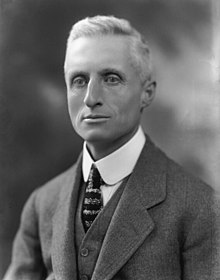Charles Alfred Bell
Charles Alfred Bell | |
|---|---|
 Bell in 1922 | |
| Born | October 31, 1870 Calcutta, India |
| Died | March 8, 1945 (aged 74) Victoria, British Columbia, Canada |
| Occupation(s) | diplomat, writer, Tibetologist |
Sir Charles Alfred Bell KCIE CMG (October 31, 1870 – March 8, 1945) was the British Political Officer for Bhutan, Sikkim and Tibet. He was known as "British India's ambassador to Tibet" before retiring and becoming a noted tibetologist.[1]
Biography[edit]

He was educated at Winchester College,[2] and then at New College, Oxford, after which he joined the Indian Civil Service in 1891.[3][4] His English-Tibetan colloquial dictionary was first published in 1905 together with a grammar of colloquial Tibetan as Manual of Colloquial Tibetan.[5]
In 1908, he was appointed Political Officer in Sikkim. He soon became very influential in Sikkimese and Bhutanese politics, and in 1910 he met the 13th Dalai Lama, who had been forced into temporary exile by the Chinese. He got to know him quite well, and later wrote his biography (Portrait of the Dalai Lama, published in 1946[6]).[7]
In 1913 he participated in the Simla Convention, a treaty between Great Britain, China and Tibet concerning the status of Tibet.[8] Before the summit, he met in Gyantse with Paljor Dorje Shatra, the Tibetan representative to the British Raj at Darjeeling and advised him to bring to Simla with him all documents concerning relations between China and Tibet, as well as Tibetan claims to land occupied by China.[9] Bell was designated to assist the Tibetans in the negotiations, with Archibald Rose assigned to be his counterpart for the Chinese.[10] He was appointed a Companion of the Order of St Michael and St George (CMG) in the 1915 New Year Honours for his services.
In 1919 he resigned as Britain's political officer in Sikkim to devote himself full-time to his research. However, London sent him to Lhasa in 1920 as a special ambassador.[11]
After travelling through Tibet and visiting Lhasa in 1920, he retired to Oxford, where he wrote a series of books on the history, culture and religion of Tibet.[12] He was awarded a knighthood for his Lhasa Mission in 1922.[4]
Palhese, Bell's Tibetan friend and confidant travelled to England in 1927-28 to assist him in editing several of these books.[4]
He moved to Canada in his later years. The book Portrait of the Dalai Lama was completed only a few days before his death on 8 March 1945.[13] Some of the photographs that he took in Tibet can be found in the Pitt Rivers Museum in Oxford.[7] Some of these were included in the 1997 book Tibet: Caught in Time.[14]
References[edit]
- ^ Dimeo, P.; Mills, J. (2013). Soccer in South Asia: Empire, Nation, Diaspora. Sport in the Global Society. Taylor & Francis. p. 91. ISBN 978-1-135-27650-8. Retrieved 11 May 2024.
- ^ "Exploring Everest: 100 years on". www.winchestercollege.org. Winchester College. Retrieved 15 September 2021.
- ^ Alex McKay (2001). "'Kicking the Buddha's Head': India, Tibet and Footballing Colonialism". In Dimeo, Paul; Mills, James (eds.). Soccer in South Asia: Empire, Nation, Diaspora. Psychology Press. p. 91. ISBN 9780714681702.
- ^ a b c "Portrait of Sir Charles Bell CMG KCIE". National Museums Liverpool. Archived from the original on 30 December 2013.
- ^ Ren, C.Y.; Noss, R.B.; Yamagiwa, J.K. (2019). Linguistics in East Asia and South East Asia. Current Trends in Linguistics. De Gruyter. p. 771. ISBN 978-3-11-081463-7. Retrieved 11 May 2024.
- ^ Bell, C.A. (2000). Portrait of a Dalai Lama: The Life and Times of the Great Thirteenth. Munshiram Manoharlal. ISBN 978-81-215-0944-2. Retrieved 11 May 2024.
- ^ a b Harris, C.; Shakya, T. (2003). Seeing Lhasa: British Depictions of the Tibetan Capital 1936-1947. Serindia. p. 141. ISBN 978-1-932476-04-0. Retrieved 11 May 2024.
- ^ McKay, A. (1997). Tibet and the British Raj: The Frontier Cadre, 1904-1947. London studies on South Asia. Curzon. p. 143. ISBN 978-0-7007-0627-3. Retrieved 11 May 2024.
- ^ Dolma, T.; Lancaster, R. (2020). Reviews on Tibetan Political History: A Compilation of Tibet Journal Articles. Political History. Library of Tibetan Works & Archives. p. 171. ISBN 978-93-87023-97-0. Retrieved 11 May 2024.
- ^ Marshall, J.G. (2005). Britain and Tibet 1765-1947: A Select Annotated Bibliography of British Relations with Tibet and the Himalayan States Including Nepal, Sikkim and Bhutan. RoutledgeCurzon. p. 443. ISBN 978-0-415-33647-5. Retrieved 11 May 2024.
- ^ Foster, Barbara M. (1987), Forbidden Journey: the life of Alexandra David-Neel, Harper & Row, ISBN 9780062503459
- ^ Michael J. Aminoff MD, D.S.F. (2016). Sir Charles Bell: His Life, Art, Neurological Concepts, and Controversial Legacy. Oxford University Press. ISBN 978-0-19-061497-3. Retrieved 11 May 2024.
- ^ Harris, David (8 March 1945). "Biography of Sir Charles Bell (1870-1945)". The Tibet Album. Retrieved 11 May 2024.
- ^ Clarke, J.; British Library (1997). Tibet: Caught in Time. Caught in Time: Great Photographic Archives Series. Garnet. ISBN 978-1-873938-96-6. Retrieved 11 May 2024.
Works[edit]
- Manual of Colloquial Tibetan. Calcutta: Baptist Mission Press, 1905. (Part II, English-Tibetan vocabulary; later editions 1919 and 1939)
- Portrait of a Dalai Lama: the Life and Times of the Great Thirteenth by Charles Alfred Bell, Sir Charles Bell, Publisher: Wisdom Publications (MA), January 1987, ISBN 978-0-86171-055-3 (first published as Portrait of the Dalai Lama: London: Collins, 1946).
- Tibet: Past and Present. Oxford: Clarendon Press, 1924
- The People of Tibet. Oxford: Clarendon Press, 1928
- The Religion of Tibet. Oxford: Clarendon Press, 1931
- Tibet: Caught in Time. Reading: Garnet, 1997. Contains photographs by Charles Bell and John Claude White
